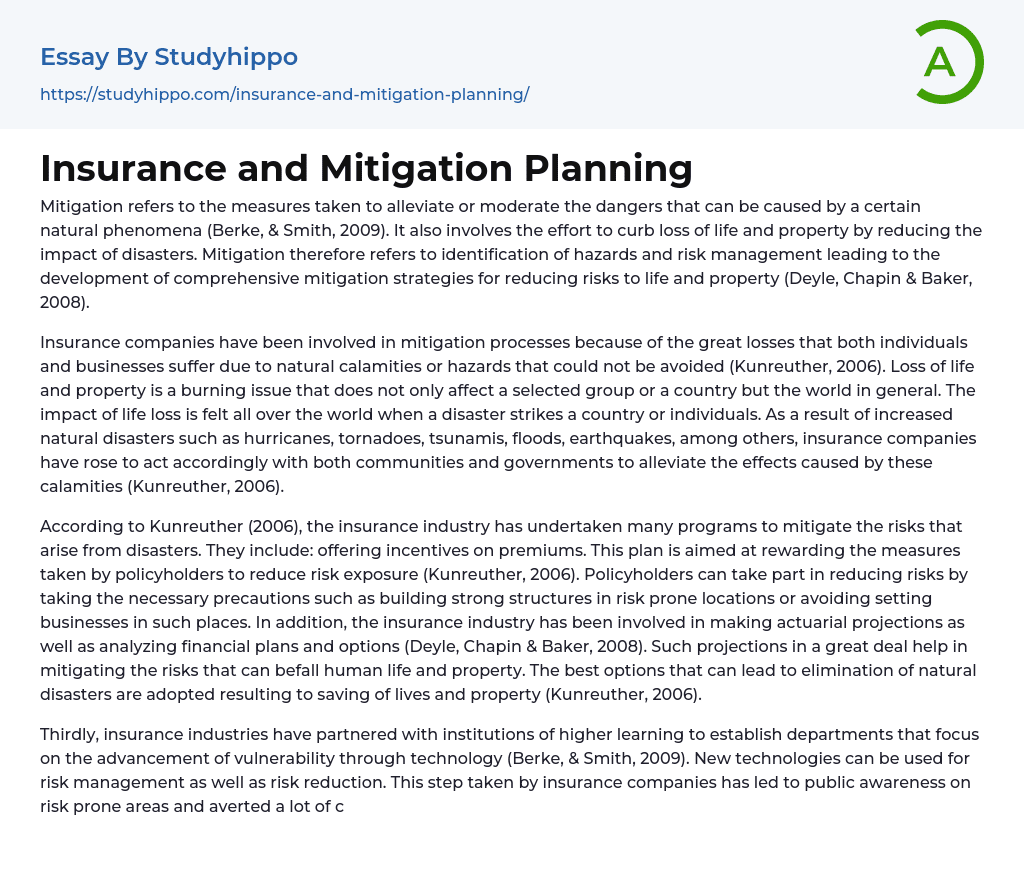Mitigation refers to the actions taken to alleviate or moderate the dangers of a specific natural phenomenon (Berke, & Smith, 2009). It also includes efforts to reduce the loss of life and property by minimizing the impact of disasters. Mitigation involves identifying hazards and managing risks to create comprehensive strategies for reducing risks to life and property (Deyle, Chapin & Baker, 2008).
Insurance companies have become involved in mitigation processes due to the significant losses experienced by individuals and businesses as a result of unavoidable natural calamities or hazards (Kunreuther, 2006). The issue of loss of life and property has a global impact, affecting not just specific groups or countries. When disasters strike, the impact of lives lost is felt worldwide. To address the effects of these calamities, such as hurricanes, tornadoes, tsunamis, floods, and earthquakes, insurance companies have collaborated with communities and govern
...ments (Kunreuther, 2006).
According to Kunreuther (2006), the insurance industry has implemented various initiatives to decrease the risks associated with disasters. These include offering an incentive on premiums, which rewards policyholders for taking measures to reduce their risk exposure. Policyholders can reduce risks by taking precautions, such as constructing sturdy buildings in high-risk areas or avoiding locating businesses in such places. Additionally, the insurance industry is involved in making actuarial projections and analyzing financial plans and options (Deyle, Chapin & Baker, 2008). These projections significantly aid in mitigating risks to human life and property.
The adoption of the best options can lead to the elimination of natural disasters, resulting in the saving of lives and property (Kunreuther, 2006). Additionally, insurance industries have collaborated with institutions of higher learning to establish departments that focu
on the advancement of vulnerability through technology (Berke, & Smith, 2009). These new technologies can be utilized for both risk management and risk reduction. As a result of this initiative by insurance companies, public awareness regarding risk-prone areas has increased, preventing potential financial burdens on governments. Educating communities to avoid such high-risk zones has contributed to this outcome (Berke, & Smith, 2009). Furthermore, insurance companies have cooperated with national construction agencies to ensure that building codes, material testing, and specifications comply with engineering and architectural designs. Adhering to these rules and guidelines has facilitated the construction of resilient structures like bridges and houses, capable of withstanding natural catastrophes (Berke, & Smith, 2009).
Hazard mapping is another program that the insurance industry has implemented as a way to reduce risk (Kunreuther, 2006). This program focuses on developing measures that require insurers to assess their level of commitment to mitigating catastrophe perils. As a result of these efforts, vulnerabilities have been reduced and disaster planning has improved through better management of land use and the implementation of legal restrictions (Berke & Smith, 2009). Additionally, insurance companies have promoted the use of protective devices to minimize the dangers faced by individuals in high-risk areas.
Moreover, communities are encouraged to use weather radios to stay informed about natural hazards and weather changes, which pose significant risks to lives and property (Deyle, Chapin & Baker, 2008). In conclusion, I disagree with insurance companies refusing to write policies in high-risk areas. By implementing proper risk mitigation measures, these regions can be transformed into habitable places. With technological advancements, the community can receive timely updates on approaching risks such as storms, typhoons, hurricanes, tornadoes,
and tsunamis, enabling them to make adequate preparations (Kunreuther, 2006).
In the event of earthquakes, it is crucial to follow building codes and conduct material testing to ensure they meet the necessary specifications (Berke, & Smith, 2009).
References
- Berke, P., & Smith, G. (2009). Hazard mitigation, planning, and disaster resiliency: Challenges and strategic choices for the 21st century. Building Safer Communities. Risk Governance, Spatial Planning and Responses to Natural Hazards, 1, 18.
- Deyle, R. E., Chapin, T. S., & Baker, E. J. (2008).
The text includes two sources with their respective citations in . The first source is titled "The proof of the planning is in the platting: An evaluation of Florida's hurricane exposure mitigation planning mandate." It is from the Journal of the American Planning Association, volume 74(3), pages 349-370.
The second source is titled "Disaster mitigation and insurance: Learning from Katrina." It is from The Annals of the American Academy of Political and Social Science, volume 604(1), pages 208-227.
- Field essays
- Afghanistan essays
- Africa essays
- America essays
- Asia essays
- Australia essays
- Caribbean essays
- City essays
- Developing Country essays
- Dubai essays
- Earthquake essays
- Europe essays
- Fracking essays
- Georgia essays
- Middle East essays
- Natural Disaster essays
- New Zealand essays
- North Korea essays
- South Korea essays
- Thailand essays
- Travel essays
- Air Pollution essays
- Carbon Dioxide essays
- Climate essays
- Deforestation essays
- Ecology essays
- Endangered Species essays
- Environmental Issues essays
- Environmental Protection essays
- flood essays
- Greenhouse Gas essays
- Hurricane essays
- Nature essays
- Pollution essays
- Renewable Energy essays
- Sustainability essays
- Tornado essays
- Traffic essays
- Tsunami essays
- Water Pollution essays




